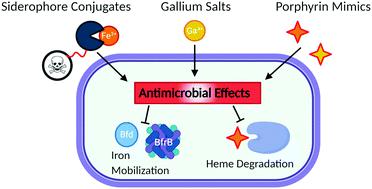当前位置:
X-MOL 学术
›
Metallomics
›
论文详情
Our official English website, www.x-mol.net, welcomes your
feedback! (Note: you will need to create a separate account there.)
Metallotherapeutics development in the age of iron-clad bacteria
Metallomics ( IF 2.9 ) Pub Date : 2020-11-17 , DOI: 10.1039/d0mt00206b Garrick Centola 1 , Fengtian Xue , Angela Wilks
Metallomics ( IF 2.9 ) Pub Date : 2020-11-17 , DOI: 10.1039/d0mt00206b Garrick Centola 1 , Fengtian Xue , Angela Wilks
Affiliation

|
Drug-resistant infections pose a significant risk to global health as pathogenic bacteria become increasingly difficult to treat. The rapid selection of resistant strains through poor antibiotic stewardship has reduced the number of viable treatments and increased morbidity of infections, especially among the immunocompromised. To circumvent such challenges, new strategies are required to stay ahead of emerging resistance trends, yet research and funding for antibiotic development lags other classes of therapeutics. Though the use of metals in therapeutics has been around for centuries, recent strategies have devoted a great deal of effort into the pathways through which bacteria acquire and utilize iron, which is critical for the establishment of infection. To target iron uptake systems, siderophore–drug conjugates have been developed that hijack siderophore-based iron uptake for delivery of antibiotics. While this strategy has produced several potential leads, the use of siderophores in infection is diminished over time when bacteria adapt to utilize heme as an iron source, leading to a need for the development of porphyrin mimetics as therapeutics. The use of such strategies as well as the inclusion of gallium, a redox-inert iron mimic, are herein reviewed.
中文翻译:

铁包细菌时代金属疗法的发展
随着病原菌变得越来越难以治疗,耐药感染对全球健康构成重大风险。由于抗生素管理不善,耐药菌株的快速选择减少了可行治疗的数量,并增加了感染的发病率,特别是在免疫功能低下的人群中。为了规避这些挑战,需要新的策略来领先于新兴的耐药性趋势,但抗生素开发的研究和资金落后于其他类别的治疗方法。尽管金属在治疗中的使用已经存在了几个世纪,但最近的策略投入了大量精力研究细菌获取和利用铁的途径,这对于感染的建立至关重要。为了靶向铁吸收系统,已经开发了铁载体-药物缀合物,其劫持基于铁载体的铁吸收来递送抗生素。虽然这种策略已经产生了一些潜在的线索,但随着时间的推移,当细菌适应利用血红素作为铁源时,铁载体在感染中的使用会减少,从而需要开发卟啉模拟物作为治疗剂。本文综述了此类策略的使用以及镓(一种氧化还原惰性铁模拟物)的包含。
更新日期:2021-01-06
中文翻译:

铁包细菌时代金属疗法的发展
随着病原菌变得越来越难以治疗,耐药感染对全球健康构成重大风险。由于抗生素管理不善,耐药菌株的快速选择减少了可行治疗的数量,并增加了感染的发病率,特别是在免疫功能低下的人群中。为了规避这些挑战,需要新的策略来领先于新兴的耐药性趋势,但抗生素开发的研究和资金落后于其他类别的治疗方法。尽管金属在治疗中的使用已经存在了几个世纪,但最近的策略投入了大量精力研究细菌获取和利用铁的途径,这对于感染的建立至关重要。为了靶向铁吸收系统,已经开发了铁载体-药物缀合物,其劫持基于铁载体的铁吸收来递送抗生素。虽然这种策略已经产生了一些潜在的线索,但随着时间的推移,当细菌适应利用血红素作为铁源时,铁载体在感染中的使用会减少,从而需要开发卟啉模拟物作为治疗剂。本文综述了此类策略的使用以及镓(一种氧化还原惰性铁模拟物)的包含。







































 京公网安备 11010802027423号
京公网安备 11010802027423号